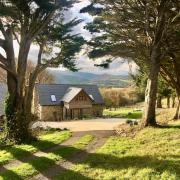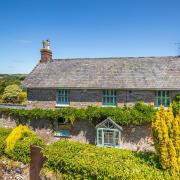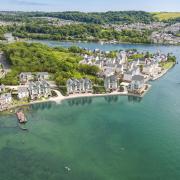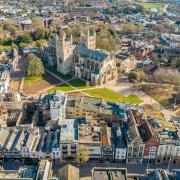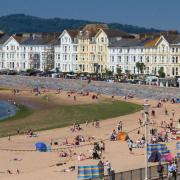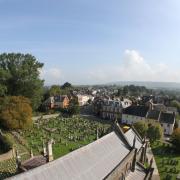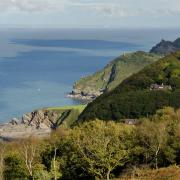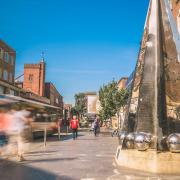As the 20th-century equivalent of the text message, the historic picture postcard also brings the story of Devon alive and shows us how different our county was 100 years ago.
'This is the way we had to land here', wrote Lizzie to her parents
on the back of a postcard of passengers landing at Clovelly. She was on holiday from Llandudno in North Wales in August 1909, and had taken one of the many steamers which dropped anchor off the picturesque village. PA Campbell's Steamers visited Clovelly from Lynmouth, Cardiff, Swansea, Clevedon and Bristol, and from several other ports along the Somerset and South Wales coasts. Lizzie does not tell us her starting point.
A century ago, in the days before every home had a telephone, and at a time when the post office collected and delivered mail several times a day, the picture postcard was the equivalent of today's text message - the quickest and most reliable way of making arrangements, contacting a friend, or just simply saying 'I'm home safely'. Cards mailed at 10am often carried the simple message 'See you tonight at 7' or something similar. At a halfpenny for a simple black and white card - and often as little as an old penny for a coloured view - and a halfpenny to post it, the postcard was the communication medium for Everyman.
Although the picture postcard was only in its infancy at that time, the range of cards available was such that collecting was already a popular hobby. 'Passengers Landing at Clovelly', showing the precarious last few feet of the journey along a narrow gangplank from rowing boat to shore, was a popular card with collectors and holidaymakers, and remained on sale for about 20 years. Local Clovelly photographer GS Riley provided the original black and white photograph, which was tinted and published as part of the 'Majestic Series' of cards.
With hundreds of cards to choose from, the sender could pick one to suit a mood, an occasion or a memory. In addition to the expected range of scenic cards - and a vastly wider range than any town or city can offer today - every stationer sold humorous postcards, romantic ones, cards which told stories or included the words of songs, and a hundred other varieties.
Many of the best tinted cards were produced in Saxony and Bavaria, where colour lithographic printing was of a much higher standard and at a much lower cost than could be found in most British printing establishments. German cards were, therefore, considered to be 'quality' items! All that changed with the advent of the Great War, of course. For the duration of the war, the purchase of remaining stock of pre-1914 cards which bore the legend 'Printed in Bavaria' was positively frowned upon as being unpatriotic - with these beautiful productions going from 'must have' to 'must not have' almost overnight. Perhaps that is why so many of them have found their way into collections today without ever having been written on or posted.
There are no reliable figures about just how many postcards were mailed annually in Britain in the early years of the last century, but it ran into hundreds of millions. And in stark contrast to the bland postcards generally available today, the Edwardians could choose from a varied and interesting range of lively and contemporary cards in just about every town and village. Of course, there were a lot of bland ones as well, but there was sufficient choice to ensure that if you were contacting a friend several times a month, then the chances of duplicating a card could be minimised.
Whereas today's seaside or coastal postcard market is aimed squarely at the tourist, whether holidaymaker or casual day visitor, Edwardian cards were aimed just as directly, if not more so, at the residents - those who lived and worked in the large seaside towns, the industrial towns and ports, and the small fishing villages. And whereas today's cards use photographs that exclude anything which might date them and limit their longevity, Edwardian cards revelled in showing local people going about their daily lives, visitors enjoying the pleasures of the seaside, and workers practising their trades and professions. An obvious aid to sales - who could have resisted buying a number of cards in which they featured prominently?
The young girl posing with her hoop and her friends in The Plantation, Exmouth, must certainly have agreed to be photographed. Was her 'fee' a number of the postcards on which she appeared?
As would be expected, there were several dozen views of the fishing boats and fishermen who worked around Devon's coast.
And would the fishermen and fisherwomen have been able to resist using 'their' cards for messages? There is clear evidence, too, that holidaymakers bought numbers of cards at seaside resorts, to be used and posted throughout the year once back home, so perhaps those seen stepping off those small boats on Clovelly beach took stocks of 'their' cards home as well.
Thanks to postcard collecting - already a popular and well-established worldwide hobby by the end of the Edwardian era - the many postcards which have been handed down to us today tell a rich story of Edwardian life. They bring history alive, vividly draw a century's change to our attention, and give us a glimpse of a time and a lifestyle so different from our own that it seems much more than a century ago.
'The Ladies Bathing Place' in Dawlish is a reminder of the fact that sea-bathing was still segregated in many places in the early Edwardian period. While the traditional seaside cards were primarily sent bearing the 'weather fine, having a grand time' sort of message, pictures like that have a considerable social history value today. Dawlish did also have a 'Family Beach' where mixed bathing was permitted, but many women still, apparently, chose to take themselves and their children to a beach where their activities were less likely to be overlooked.
Devon's most important coastal city, Plymouth, was a trading port, a fishing port and a naval base, and its Edwardian postcards reflect its multitude of faces. Postcards of fishermen washing their nets on the Barbican Fish Quay must have been produced in huge numbers for there are many of them still about today, and few of them ever written on.
Cards of naval activities are a bit less common, but one series dating from about 1906 included several cards designed to show the gentler side of the navy. HMS Ariadne may not have spent much of her working life at Devonport, but during one visit she became the subject for a series of postcards. One card published, called 'The Handy Man - A Stitch in Time', shows a sailor busy darning his tunic. HMS Ariadne, an 11,000-ton Diadem Class, four-funnel cruiser, was launched in 1898, and sunk in 1917.
This was the golden age of the picture postcard, but one which did not last long. The increasing popularity of illustrated newspapers and then illustrated magazines - and the onset of a devastating world war - had a considerable impact on the postcard market, and after peace returned, the range of cards available never again achieved the rich variety available to the Edwardians.
JOHN HANNAVY
Several of these pictures appear, in colour, in John Hannavy's book Britain's Working Coast in Victorian and Edwardian Times, published by Shire, priced �9.99.



